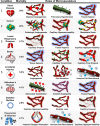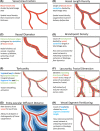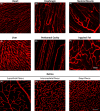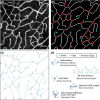Methods to label, image, and analyze the complex structural architectures of microvascular networks
- PMID: 30548558
- PMCID: PMC6561846
- DOI: 10.1111/micc.12520
Methods to label, image, and analyze the complex structural architectures of microvascular networks
Abstract
Microvascular networks play key roles in oxygen transport and nutrient delivery to meet the varied and dynamic metabolic needs of different tissues throughout the body, and their spatial architectures of interconnected blood vessel segments are highly complex. Moreover, functional adaptations of the microcirculation enabled by structural adaptations in microvascular network architecture are required for development, wound healing, and often invoked in disease conditions, including the top eight causes of death in the Unites States. Effective characterization of microvascular network architectures is not only limited by the available techniques to visualize microvessels but also reliant on the available quantitative metrics that accurately delineate between spatial patterns in altered networks. In this review, we survey models used for studying the microvasculature, methods to label and image microvessels, and the metrics and software packages used to quantify microvascular networks. These programs have provided researchers with invaluable tools, yet we estimate that they have collectively attained low adoption rates, possibly due to limitations with basic validation, segmentation performance, and nonstandard sets of quantification metrics. To address these existing constraints, we discuss opportunities to improve effectiveness, rigor, and reproducibility of microvascular network quantification to better serve the current and future needs of microvascular research.
Keywords: blood vessels; image analysis; image quantification; microvasculature; vascular network; vessel architecture.
© 2018 John Wiley & Sons Ltd.
Figures






References
-
- Nourshargh S, Alon R. Leukocyte migration into inflamed tissues. Immunity. 2014;41(5):694‐707. - PubMed
-
- Tonnesen MG, Feng X, Clark RAF. Angiogenesis in wound healing. J Investig Dermatol Symp Proc. 2000;5(1):40‐46. - PubMed
-
- Chambers R, Zweifach BW. Intercellular cement and capillary permeability. Physiol Rev. 1947;27(3):436‐463. - PubMed
-
- Pantoni L. Cerebral small vessel disease: from pathogenesis and clinical characteristics to therapeutic challenges. Lancet Neurol. 2010;9(7):689‐701. - PubMed
Publication types
MeSH terms
Grants and funding
LinkOut - more resources
Full Text Sources
Other Literature Sources
Medical

